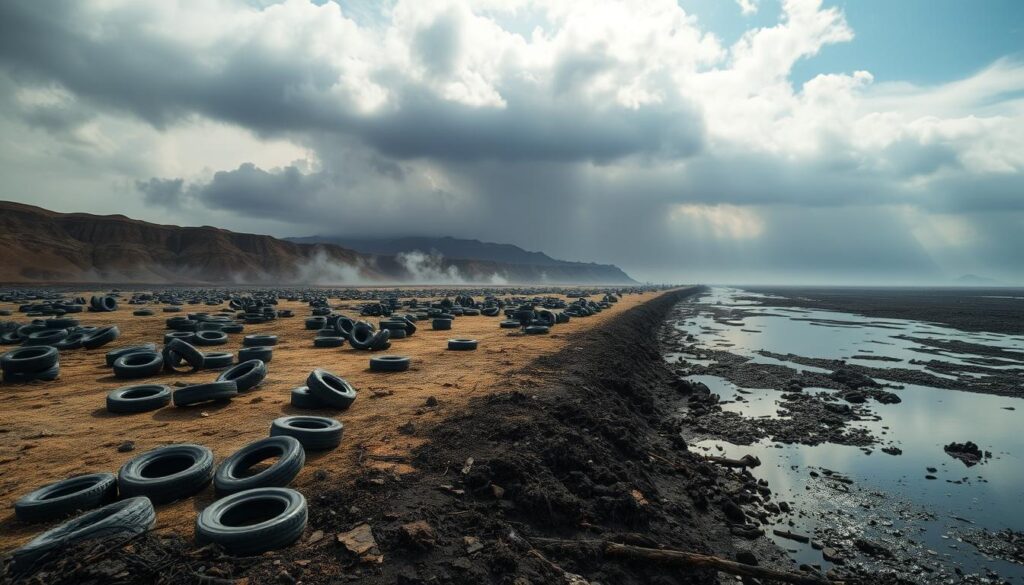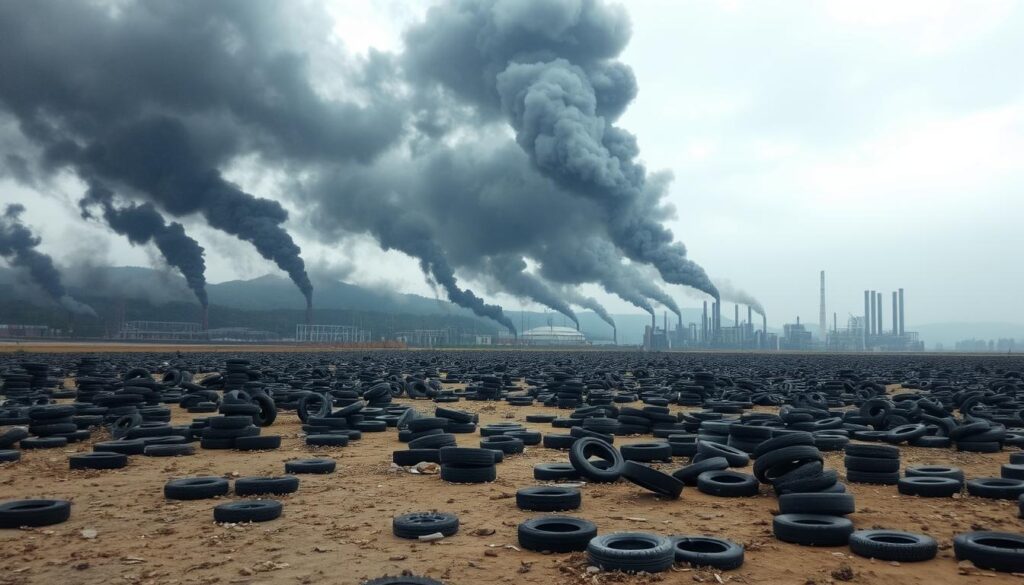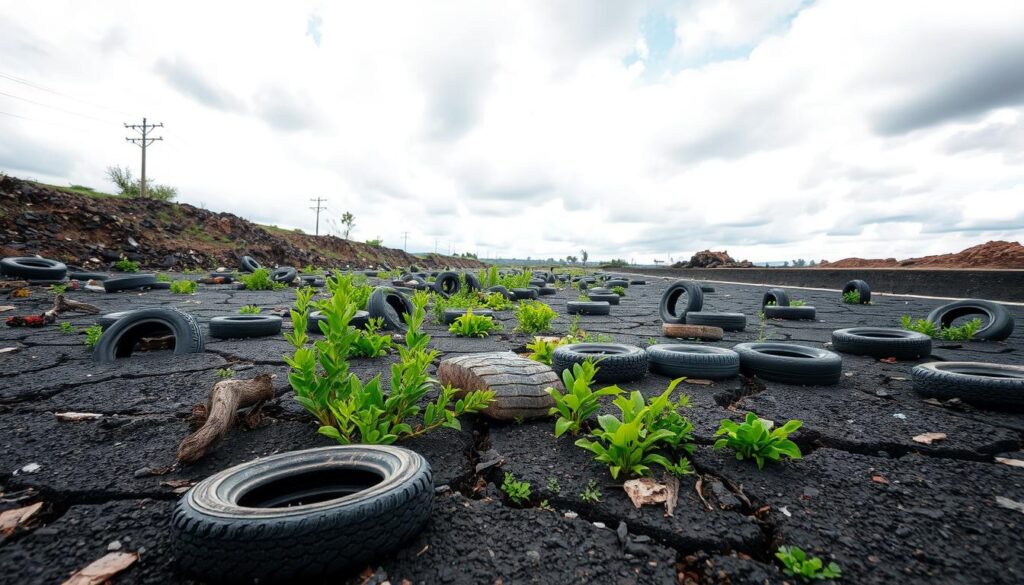In today’s fast-paced industrial world, waste rubber and black pollution have become a major environmental crisis. This problem affects areas worldwide, causing significant harm. We will explore the complexities of black pollution, its history, and the alarming statistics highlighting the need for action.

Rubber, a key material in our daily lives, has become a significant contributor to waste. The improper disposal of used tires and industrial byproducts has led to black pollution. This pollution is a serious threat to our planet. It’s essential to understand this issue to develop effective solutions.
Understanding Black Pollution: A Growing Environmental Crisis
Black pollution, a term that has gained increasing attention in recent years, refers to the dark particulate matter that contributes to air quality deterioration. This environmental crisis is not only a growing concern but also a complex issue with far-reaching implications for our planet.
Components of Black Pollution
Black pollution is primarily composed of soot, carbon, and other fine particulate matter primarily generated from the incomplete combustion of fossil fuels. This includes vehicle emissions, industrial processes, and even wildfires. These microscopic particles can penetrate deep into the lungs, posing serious health risks and contributing to respiratory ailments.
Historical Development of the Issue
The problem of black pollution has its roots in the Industrial Revolution. The widespread use of coal and other fossil fuels led to a dramatic increase in air pollution. Over the decades, as industrialization and urbanization accelerated globally, the issue of black pollution has only intensified. Some regions struggle to maintain acceptable air quality standards.
Current Global Statistics
Recent data paints a concerning picture of the global black pollution crisis. According to the World Health Organization, air pollution is responsible for millions of premature deaths each year. Black carbon particles are a significant contributor. Numerous cities around the world continue to grapple with high levels of black pollution. This compromises the health and well-being of their residents.
The Global Scale of Waste Rubber Accumulation
The buildup of waste rubber has become a critical environmental issue globally. With the world economy expanding, the need for rubber products, especially in transport and manufacturing, has skyrocketed. This rise in demand has led to a massive increase in waste rubber, posing significant environmental challenges.
Recent reports indicate that the waste rubber stockpile has reached record levels. Millions of tons of discarded tires, conveyor belts, and other rubber products are accumulating in landfills, abandoned lots, and even natural habitats. This alarming pollution trend affects not just one region but is a worldwide issue. Asia, North America, and Europe are among the most impacted areas.
The sheer volume of waste rubber not only creates an eyesore but also poses severe threats to the environment. As this non-biodegradable material decomposes, it releases harmful chemicals and microplastics into the soil, air, and water. This disrupts ecosystems and poses health risks to humans and animals. The urgency for sustainable solutions to this crisis has never been greater.
pollution, environment black pollution, waste rubber
The environmental crisis demands we understand waste rubber’s chemical makeup and its ecological effects. Rubber, essential in many industries, significantly contributes to pollution. This is mainly due to the buildup of waste tires and other rubber items.
Chemical Composition of Rubber Waste
Rubber waste is a complex mix of polymers, fillers, and additives. It includes vulcanized rubber, carbon black, and various chemicals. The exact composition varies by rubber type and manufacturing process. Grasping these details is key to managing waste rubber’s environmental impact.
Environmental Degradation Patterns
Improper disposal of rubber waste causes severe environmental harm. *Rubber waste can take hundreds of years to decompose naturally.* During this time, it can release harmful chemicals into the soil and groundwater. This contaminates the environment. Burning waste rubber also releases toxic gases and particulates, worsening air pollution.
Impact Assessment Methods
Measuring the effects of pollution, black pollution, and waste rubber on the environment is complex. Experts use soil and water analysis, air quality monitoring, and ecological studies. These methods help quantify damage and guide solution development.
Health Implications of Rubber-Based Air Pollutants
The rise in rubber-based air pollutants is alarming for public health. These pollutants, from industrial processes and transportation, harm the respiratory system, cardiovascular health, and overall well-being.
Exposure to air quality problems from rubber waste causes various health issues. These include respiratory irritation, asthma worsening, and reduced lung function. The tiny particles and volatile organic compounds from rubber breakdown can deeply penetrate lungs. This triggers inflammation and affects respiratory health.
Moreover, pollution from rubber sources is connected to heart disease and stroke risks. The toxins and chemicals in these pollutants disrupt the cardiovascular system. This leads to severe effects.
Long-term exposure to these pollutants may also lead to neurological issues, endocrine disruption, and cancer. Ongoing research aims to fully grasp the environmental challenge’s wide-ranging impacts.
Industrial Sources of Black Pollution
Black pollution is more than just visible soot and particulates in cities. It stems from deep within industrial processes across various sectors. Industries like manufacturing, transportation, and construction are key contributors to black pollution in our air, water, and soil.
Manufacturing Processes
Activities like rubber and plastic production release a lot of black carbon and pollutants. _The burning of fossil fuels_ in these processes is a major cause. It leads to harmful particulates that worsen air quality and contribute to climate change.
Transportation Sector Impact
The transportation sector is a significant source of black pollution. Vehicle emissions, especially from diesel engines, are a major problem. _The exhaust from trucks, buses, and heavy-duty vehicles_ is a big contributor to black carbon and pollutants in urban and suburban areas. This pollution affects local air quality and has broader environmental impacts.
Construction Industry Contribution
The construction industry also contributes to black pollution. Demolition, cement production, and heavy machinery operation release black carbon and pollutants. _This pollution can harm local environments, affecting air, water, and soil quality in nearby communities._
Tire Waste Management Challenges
The issue of tire waste management poses significant challenges for the environment. *Waste rubber* from discarded tires is a growing concern, as improper disposal can lead to severe pollution and environmental degradation. Tire waste management requires a multi-faceted approach to address the complex and wide-ranging impacts.
One of the primary challenges is the sheer volume of tire waste generated globally. As the transportation sector continues to expand, the number of discarded tires continues to rise, placing a strain on waste management systems. Proper disposal methods, such as landfilling or incineration, often face limitations, as these methods can contribute to air, soil, and water pollution.

Additionally, the recycling of tire waste presents its own challenges. The complex chemical composition of tires makes it difficult to find viable and cost-effective recycling solutions. The lack of widespread infrastructure and the limited market for recycled tire products further exacerbate the issue, making it challenging to divert tire waste from landfills and incineration.
The environmental impact of improper tire disposal is a significant concern. When tire waste is left to accumulate or is burned, it can release harmful chemicals and particulates into the air, contaminate soil and groundwater, and disrupt natural ecosystems. This, in turn, can have far-reaching consequences for the health of both the environment and the surrounding communities.
Addressing the challenges of tire waste management requires a holistic approach, involving collaboration between policymakers, industry stakeholders, and environmental advocates. Innovative recycling technologies, improved waste collection systems, and comprehensive legislation can all play a crucial role in mitigating the environmental impact of this growing issue.
Environmental Impact on Water Resources
The growing problem of waste rubber and black pollution has severe effects on our water resources. This widespread environmental issue threatens groundwater, marine ecosystems, and poses major hurdles for water treatment. It’s a critical issue that demands immediate attention.
Groundwater Contamination
Waste rubber from tires, industrial activities, and other sources can contaminate soil. This contamination can then seep into groundwater, posing a significant risk. Pollution from waste rubber introduces toxic substances like heavy metals and PAHs. These pollutants can severely compromise the quality and safety of our groundwater.
Marine Ecosystem Effects
The environmental impact of waste rubber is not limited to land. Microplastics and rubber particles can enter waterways and the ocean. This disrupts marine ecosystems and threatens the health of aquatic life. These pollutants can accumulate in the food chain, affecting marine organisms and humans who consume them.
Water Treatment Challenges
Dealing with the waste rubber crisis is a significant challenge for water treatment facilities. Traditional purification methods may not effectively remove certain contaminants. This calls for the development of advanced technologies to ensure water safety and quality.
Air Quality Deterioration from Rubber Processing
The production and processing of rubber materials significantly impact air quality, contributing to the growing environmental crisis known as “black pollution.” During manufacturing, various pollutants are released into the atmosphere, compromising the air we breathe.
The chemical composition of rubber waste, including volatile organic compounds (VOCs) and particulate matter, is a major concern. These emissions can linger in the air, leading to long-term regional air quality deterioration. The transportation sector and construction industry are also major contributors to black pollution, further exacerbating the problem.
Studies have shown that the environmental impact of rubber-based air pollutants can be far-reaching, affecting both local and global air quality. The accumulation of these pollutants in the atmosphere can lead to smog, reduced visibility, and increased health risks for nearby communities. Addressing the issue of air quality deterioration from rubber processing is crucial in the fight against environmental degradation.
Sustainable Solutions for Rubber Waste Management
The escalating global crisis of waste rubber and pollution demands urgent action. Innovative recycling technologies, alternative materials, and policy changes offer promising solutions. These efforts aim to mitigate the environmental impact of waste rubber.
Recycling Technologies
Recycling is crucial in combating waste rubber and environmental degradation. New recycling technologies transform discarded tires and rubber products into valuable materials. This approach reduces landfill waste and the need for virgin rubber, lowering extraction and production pollution.
Alternative Materials
Exploring alternative materials to traditional rubber is another sustainable strategy. Researchers and manufacturers are developing bio-based and synthetic options. These alternatives aim to reduce reliance on waste rubber and support a circular economy.
Policy Implementations
Governments and policymakers are key in promoting sustainable waste rubber management. By enforcing regulations, offering incentives, and fostering collaborations, they can drive innovation. This helps in adopting recycling technologies, using alternative materials, and promoting environmental responsibility. Effective policies are essential for addressing pollution from waste rubber and ensuring a sustainable future.

Economic Impact of Black Pollution
The effects of black pollution, or environmental pollution, go beyond immediate environmental harm. It significantly burdens the economy, impacting various sectors and community well-being. Healthcare costs and environmental cleanup expenses are just the beginning of the economic fallout from black pollution.
Public health systems face a major challenge due to black pollution. Exposure to it can lead to respiratory issues, heart disease, and cancer. Treating these conditions is costly, affecting both individuals and healthcare systems. Moreover, reduced worker health and productivity lead to significant economic losses.
Environmental degradation from black pollution also has economic repercussions. Cleaning up contaminated soil, water, and air requires substantial investment. The loss of natural ecosystems and biodiversity further threatens economic stability. These resources are vital for sustaining economic activity and supporting local communities.
It’s essential to tackle the economic effects of black pollution for long-term community prosperity. Investing in sustainable solutions like renewable energy and emission-reduction technologies offers substantial benefits. These efforts not only reduce immediate costs but also ensure a more resilient and prosperous future.
Future Projections and Environmental Concerns
The world faces significant challenges from environment, pollution, and waste rubber. Yet, there’s hope for progress. Experts advocate for a comprehensive strategy to tackle this complex issue.
Climate Change Implications
The buildup of waste rubber and pollution poses severe threats to our environment. Scientists fear that emissions from rubber products could worsen climate change. This could alter global temperatures, sea levels, and extreme weather events.
Technological Advancements
However, new technologies offer a glimmer of hope. Recycling innovations and alternative materials aim to reduce waste rubber‘s environmental impact. These advancements could lead to more sustainable practices.
Global Policy Trends
Global leaders are now prioritizing environmental issues caused by pollution and waste rubber. Governments and international bodies are setting stricter rules and promoting eco-friendly initiatives. Their goal is to foster sustainable change and protect our planet.
Looking ahead, a comprehensive strategy is essential. It must include technological breakthroughs, policy changes, and public education. By working together, we can aim for a greener, more resilient future.
Conclusion
The crisis of waste rubber and black pollution requires our urgent attention. Our detailed exploration has revealed the massive scale and severe consequences of this global issue. The chemical makeup of rubber waste and its harmful effects on water, air, and health are stark reminders of the need for action.
Fortunately, sustainable solutions are available, from recycling technologies to eco-friendly materials. Yet, solving this problem demands a comprehensive effort. Policymakers, industry leaders, and citizens must work together. We must focus on effective waste management, promote green alternatives, and enforce strict regulations to combat black pollution.
Immediate action is crucial to protect our environment and secure a sustainable future. The effects of inaction will worsen, damaging our planet irreparably. It’s time to act, preserving our natural resources and striving for a world free from waste rubber and black pollution.